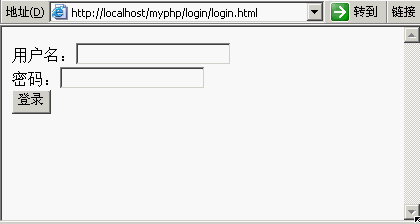php+MySql实现登录系统与输出浏览者信息功能
本系统,与之前在《ASP 连接Access数据库的登陆系统》(点击打开链接)一文中的asp登录系统的思想完全一样,只是编程语言从asp变成了php,数据库从Access变成了mysql。
一、基本目标
首先在mysql存在着如下的用户信息表:

在页面中有一个登录表单,上面需要用户填写用户名与密码等信息
如果用户输入的用户名在用户信息表里面根本就没有,那么则弹出“查无此人”的对话框,并返回本页

如果用户输入的密码错误,那么则弹出“密码错误”的对话框,并返回本页

如果用户输入的登录信息正确,那么则跳到“登录成功”的页面,并输出用户当前的IP、使用的系统的语言环境、与浏览器信息

“登录成功”的页面是被保护的,浏览器并不可以通过在浏览器中输入地址的方式,绕开输入密码的页面,直接访问“登录成功”页面

二、基本思想

用户输入用户名与密码的那一页用静态页面,只要其表单指向登录判断页login.php就可以了。
welcome.php是用户成功登录的页面,
exit.php用来销毁session。
session就是用来存放用户名与密码的浏览器全局变量。
三、制作过程
(1)login.html
没什么好说的,就一个登录表单,见如下代码:
<!DOCTYPE html PUBLIC "-//W3C//DTD XHTML 1.0 Transitional//EN" "http://www.w3.org/TR/xhtml1/DTD/xhtml1-transitional.dtd"> <html xmlns="http://www.w3.org/1999/xhtml"> <head> <meta http-equiv="Content-Type" content="text/html; charset=utf-8" /> <title>登录页面</title> </head> <body> <form action="login.php" method="post"> 用户名:<input type="text" name="username" /><br /> 密码:<input type="password" name="password" /><br /> <input type="submit" value="登录" /> </form> </body> </html>
(2)exit.php
销毁session页面,并且在销毁session之后,把页面打回login.html
值得注意的是,在php一旦需要使用session,就应该在所有代码的第一行使用session_start();系统函数,否则可能会出错
<!DOCTYPE html PUBLIC "-//W3C//DTD XHTML 1.0 Transitional//EN" "http://www.w3.org/TR/xhtml1/DTD/xhtml1-transitional.dtd"> <html xmlns="http://www.w3.org/1999/xhtml"> <head> <meta http-equiv="Content-Type" content="text/html; charset=utf-8" /> <title>登出页面</title> </head> <body> <?php session_start(); session_destroy(); ?> <script> window.location.href="login.html"; </script> </body> </html>
(3)login.php
登录判断页面,还是经典的登录三段论,首先接收login.html传递过来的username与password,查询用户信息表中是否有这个username,如果没有,再登录失败,如果有,再同时判断传过来的、用户输入的password是否等于这个username在数据库中对应的dbpassword,如果是,登录成功,并把username存入session,传递给登录成功页面,否则登录失败。
本页面还用到了系统内置函数is_null判断查询结果是否为空,如果数据库查询结果为空,根本就不会有值赋予给新定义的dbusername,这个dbusername依旧为空。
同时,如果登录成功之后,还要使用mt_rand(0,100000);在0~100000中产生一个保护登录成功页面的随机数code。
并且做完一切判断之后,记得在最后加入一条关闭数据库的语句,人走带门。
<!DOCTYPE html PUBLIC "-//W3C//DTD XHTML 1.0 Transitional//EN" "http://www.w3.org/TR/xhtml1/DTD/xhtml1-transitional.dtd">
<html xmlns="http://www.w3.org/1999/xhtml">
<head>
<meta http-equiv="Content-Type" content="text/html; charset=utf-8" />
<title>登陆中……</title>
</head>
<body>
<?php
session_start();
$username=$_REQUEST["username"];
$password=$_REQUEST["password"];
$con=mysql_connect("localhost","root","root");
if(!$con){
die("数据库连接失败!");
}
mysql_select_db("test",$con);
$dbusername=null;
$dbpassword=null;
$result=mysql_query("select * from user where username='".$username."';");
while($row=mysql_fetch_array($result)){
$dbusername=$row["username"];
$dbpassword=$row["password"];
}
if(is_null($dbusername)){
?>
<script>
alert("查无此人!");
window.location.href="login.html";
</script>
<?php
}
else{
if($dbpassword!=$password){
?>
<script>
alert("密码错误!");
window.location.href="login.html";
</script>
<?php
}
else{
$_SESSION["username"]=$username;
$_SESSION["code"]=mt_rand(0,100000);
?>
<script>
window.location.href="welcome.php";
</script>
<?php
}
}
mysql_close($con);
?>
</body>
</html>
(4)welcome.php
在welcome.php成功登录页面中,先要用isset来判断是否有login.php传递过来的code,这里的isset与上面is_null的区别,isset是判断有没有这个变量,is_null是在有这个变量的前提下,判断这个变量是否为null,如果没有code这个session则说明用户非正常途径登录的,马上扔到exit.php再见走人
如果是正常登录,则通过server对象里面的各个小对象输出用户信息。
<!DOCTYPE html PUBLIC "-//W3C//DTD XHTML 1.0 Transitional//EN" "http://www.w3.org/TR/xhtml1/DTD/xhtml1-transitional.dtd">
<html xmlns="http://www.w3.org/1999/xhtml">
<head>
<meta http-equiv="Content-Type" content="text/html; charset=utf-8" />
<title>欢迎登录</title>
</head>
<body>
<?php
session_start();
if(isset($_SESSION["code"])){
?>
欢迎登录!<?php
echo "${_SESSION["username"]}";
?><br />
你的IP:<?php
echo "${_SERVER['REMOTE_ADDR']}";
?>
<br />
你的系统语言:<?php
echo "${_SERVER['HTTP_ACCEPT_LANGUAGE']}";
?>
<br />
你的浏览器为:<?php
echo "${_SERVER['HTTP_USER_AGENT']}";
?>
<br />
<a href="exit.php">退出登录</a>
<?php
}
else{
?>
<script>
alert("请正常登录!");
window.location.href="exit.php";
</script>
<?php
}
?>
</body>
</html>
至此,整个登录系统开发完成。
以上就是本文的全部内容,希望对大家的学习有所帮助,也希望大家多多支持【宜配屋www.yipeiwu.com】。